CHAPTER 5
RAPID AMONIACAL SILVER
ammoniacal photographic emulsion, orthochromatic, liquid light, sensitive silver photo emulsion given here of saul
bolaño's, PHOTOGRAPHIC SILVER EMULSIONS BOOK. ammoniacal silver photographic emulsions formulas are given
below and are part of this book: chapter 5, a complete illustrated report of the making positive rapid amonniacal
silver bromide gelatine emulsions, for paper and glassplates or films.USE THIS EMULSION
FOR POSITIVE PAPER AND TESTING GELATINE
Ammoniacal Positive silver gelatine Emulsion Formula # 1.
ASA 3 to ASA 6 For High Contrast Clean Enlarging photographic
Bromide Paper, and for the testing of different types of gelatines.This Excellent Formula that i worked out is Beyond
Reproach. It produces no Fog. Unsurpassed for First Trials With any Good Gelatine or
Most Gelatines - It yields High Contrast, Superb Blacks and Clean Whites with a Good
Speed for Enlarging Paper or Low Speed Negative Work It Should also be Used for Testing of Gelatines. Follow Direction
Carefully. IN FIRST TRIAL TO AVOID FOG :
1. Do not “First Ripen” that is Arrest Heat
Inmediately After Precipitation or Mixing of solution A with solution B
2. Do not Precipitate with Temperatures Above 38 c
(100 f). How to Re disolve the Silver Nitrate with Ammonia in
solution B as given in emulsion formula below.
 Formula Number 1 Positive
Emulsion To make 0.5 Liters of Finished
Emulsion
Formula Number 1 Positive
Emulsion To make 0.5 Liters of Finished
Emulsion
A. Salts Solution Heated to 35-38c
(95-100 f )
Dissolve in order given
Distilled Water ......................120 ml
10% solution of Potassium Iodide....2 ml
potassium bromide 8 grams
flavorless and colorless gelatine 20 grams.
--------------------------------------------------------------
B. Silver Solution, use at room
temperature
Distilled Water ........120 ml
Silver Nitrate ........ 10 grams
Dissolve and Ammonia Until Silver is Re-dissolved
-------------------------------------------------------------------------
C. extra Gelatin: Add after
washing:
Dry flavorless and colorless gelatine
( if in leaf form cut into small pieces) ..20 grams
------------------------------------------------------------------------
D. antifoggant: Add after
washing: Just Before second ripening
10 % solution of Potassium Bromide: ..1 ml
------------------------------------------------------------------------
E. Finals:
Add all of the 4 ingredients below mixed together in one single solution.
To every
"100 ml" of “finished" emulsion after washing
and at the end of second ripening; just before coating. (for 500 ml
of Emulsion use 5 times as much as the quantity given)
---------------------------------------------------------------------------------------------
As stabilizer for Longer Shelf life of coated material on storage:
10 % solution of potassium Bromide: 1 ml
---------------------------------------------------------------------------------------------
Gelatine Hardener to prevent frilling of gelatine
emulsion on glass plates or damage on paper during processing:
5 % Chrome Alum solution. ........ 1 ml
-------------------------------------------------------------------------------------------
As coating aid to make Emulsion flow and Spread easy :
Ethyl Alcohol (the type people drink) . 5 ml
-----------------------------------------------------------------------------------------
-Antiseptic to keep uncoated emulsion in liquid
form under
refrigeration for 12 months with out spoiling:
10 % alcoholic solution of salicylic acid: 2 ml.
Emulsion Data
Excess Halide:..................15 %
Potassium Iodide of the weight
of the Silver Nitrate: ....2 %
Concentration of Precipitants:
KBR...............................6.66 %
Silver Nitrate.............. about 8 %
RATIO: Ag / Gel ...............1:4
INSTRUCTIONS: Precipitation: Under Dark Red Light
1. After Preparing Solutions A, B, C, D, and
E
-Mix emulsion and work in Dark Room under “ Red Light” from this point onward.
do not add more ammonia to silver solution than is necessary to re-dissolve the brown precipitate that is formed.
Excess ammonia may give emulsion lower contrast.
After carefully Re-dissolving the silver with excess of ammonia as described, Add silver sol
B to salts sol A in a fine stream between 10 to 30 seconds while at the same
time stirring the salts solution briskly all the time. Stir the salts solution with a plastic fork or better with a
stainless steel wire beater.
See graphic chapter on Emulsion Mixing or Precipitation, At the end of mixing cool the
emulsion immediately by placing the vessel in an ice water bath. Once emulsion has set into a stiff jelly as firm as a
hard rubber, shred and wash.
2. Wash for 60 minutes
consistency is
important: 12 changes of water. Each change with 2 liters of water lasting 5 minutes
each with frequent agitation. Add free bromide to washing water. See graphic chapter on washing,
3. After washing, drain & Melt in Hot water bath
at 45 - 50c (113-122 f) See graphic chapter on washing and second ripening. Most emulsions will be flat with low
contrast and no real blacks if coated right after washing. The silver bromide must absorb sensitizers naturally present
in the gelatine to give high contrast and higher light sensitivity. To effect this, the washed emulsion, right after
melting, is submitted to a digestion or cooking by heat for some time.
This digestion by
heat is called "Second Ripening" (or chemical ripening) The
first ripening being the amount of time emulsion was heated right after mixing and before washing. The time of second
ripening at any given temperature will depend above all on the type of gelatine, its amounts of restrainers and
sensitizers. At 50c (122 f ) ripening may take 15 minutes to 1 or 2 hours. At
55 c (131 f ) much less time, at 45c (113 f) still much longer.
Temperature consistency is of utmost importance for
repeating results. When First ripening time is taken much longer than the amount
of time given with the present emulsion formula, the second ripening time must be
reduced to avoid fog. Tests must be made (as given below) to ascertain the optimum time for any particular make of
gelatine and emulsion formula. With the present emulsion formula second ripening temperature has been given at 50c /122
f which is a safe rapid temperature for second ripening of ammonia emulsions,
55c (131 f) is
TOO VIOLENT ! of a ripening temperature for ammonia emulsions, changes occur too rapidly within, the emulsion for testing comfortably.
The optimum second ripening temperature for the "Highest
Contrast " with ammonia emulsions is 45c (113f) AND NO
HIGHER.
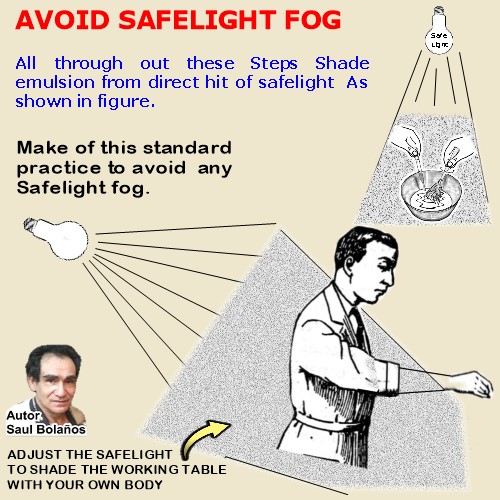
4. Right After Washing Bring to Required Volume
Before Second Ripening immediately after washing, melt washed emulsion in a 1 liter
beaker or glass jar previously marked at 450 - 500 ml volume; add enough distilled water to bring to a volume of 450 ml
and add the dry extra gelatine C. Stir solution gently to wet the gelatine and
dissolve it, this may take about 10 minutes at 45 - 50c. Stir a while to melt any remaining un dissolved gelatine.
Probe with your fingers (emulsion is not toxic) When gelatine has all dissolved, add antifogging D, and little more water to bring the final volume to a 500 ml.
5. Divide emulsion into 5 equal lots of 100 ml each and Second
Ripen in Hot Water Bath at 50C /122 f for 1. 5 hours. After washing,
melting and bringing volume to a total of 500 ml, and adding the extra gelatine and antifogant as directed previously,
divide emulsion in 5 lots of 100 ml each. Put a lid on each separate glass jar
containing each lot of 100 ml of emulsion. Place each emulsion lot under refrigeration (about 5-10 degrees Celsius) in
an absolutely light proof container. Submit one of the 100 ml emulsion lots (with lid on so as not to condense
emulsion) to a digestion or cooking (ripening) in a water bath at 50c, for 1.5 hours. This digestion by heat after
washing is called second ripening. Agitate the emulsion vessel at least once
every 10 minutes during this ripening.
6. At the end of Second Ripening add the "Finals" to every "100 ml " of Ripened emulsion. Right before coating add
the finals solution E, which is dosed with free bromide to retard further
ripening.
7. Store Liquid “finished” Emulsion in refrigerator or coat at 35c Store uncoated
emulsion in refrigeration or coat at 35c for testing. Coat pure cotton fiber watercolor paper, with 3 thin but uniform
coats of emulsion, ( with a soft brush) drying each layer with cold or warm air for 5 - 10 minutes or until dry, before
applying the next.
(see Chapter on “Coating 35 mm Glass Plates & Paper ”
8. Test the Ripened "finished"
emulsion Cut a strip of the coated paper, expose under a standard black and white silver negative of normal
contrast, enlarged to 2 x by projection with enlarging lens wide open. Always use same arrangements for testing.
Develop in a clean paper developer( formula given in this book) like Kodak's decktol diluted 1:2 for 1.5 minutes
exactly at 23c (73 f) keep temperature constant. Never above 23c (73f) because emulsions start producing fog above that
temperature. Start with trial exposures of 2,4, and 8 seconds. Use a hardening fixing
bath. Under this given conditions, with a second ripening time of 1.5 hours
at 50c: assuming you did not fog emulsion by badly weighting of reactants, and that
emulsion was not fogged by unsafe red safelight during coating and processing (or white light during storage) you
should have an excellent high contrast print with pure whites, no fog, and deep strong and brilliant blacks.
You will
obtain this good result with about 95 % of all "photo grade" gelatines and about 80 % of all “food grade” or
Edible gelatines. The best food grade gelatines for emulsion making come in leaf form (Gelitas brand see Chapter on
gelatine). Avoid food grade gelatines in powdered form. See what has been explained above graphically in next
pages.
Approximate Ripening Temperature
Equivalents:
1.5 hours 50c (122 f) = to 3 hours at 45c (113 f ) or 45 minutes at 55c (131 f )
The
beginner is strongly advised to Second Ripen with only one temperature: 50c (122 f ) and not to change it.
Graphics Steps on EMULSION MIXING: Prepare the silver solution.
1. Weight the silver
nitrate and potassium bromide separately . Never mix with each other weather wet or dry. The only time they should mix
is in the presence of gelatine under red light. Rinse dropper thoroughly with distilled water after contacting one
chemical before contacting the next. That is an absolute unbreakable rule. Weighting is
critical, it has to be exact. Use same size of paper to weight
chemicals. Use same weights to weight the silver as well as the bromides. Use gloves to handle the silver nitrate
protect you eyes.
2. dissolve the silver,
in distilled water at room tempera-ture. Stir with plastic spoon.
3. Once the silver has dissolved, with a dropper add strong ammonia (25-35%)
until precipitate redissolves giving a water clear solution. See page with ammonia bromide emulsion formula where a
full detailed description is given on how to do this. After use set spoon aside to rinse later. Rinse dropper
thoroughly with distilled water if it is to be used again for the salts solution.
4. if heat is evolved after redisolving silver with the ammonia, set the silver sol
aside to cool to room temperature before use.
5. Prepare now the salts solution After weighting the potassium bromide, In a 1.5 liter glass mixing bowl,
add the required quantity of
distilled water at room temperature and add and dissolve the potassium bromide.
6. After dissolving the potassium bromide add with a 1 ml dropper, the exact quantity
( 2ml ) of
potassium iodide from a 10% solution as given in formula.
 7. After weighting cut the
gelatine (if in leaf form) in small pieces so it will fit on vessel and wet and dissolve much faster.
7. After weighting cut the
gelatine (if in leaf form) in small pieces so it will fit on vessel and wet and dissolve much faster.
8. By room temperature soak the gelatin in the cold salts solution until it becomes
limp and flexible, stir about a minute to wet at all point as much as possible. Leave soaking about 15 - 30 minutes
before melting.
9. After soaking melt gelatine in salts solution in hot water bath at 45 -50c.( 113 -
122 f ) stir with a plastic spoon. Once completely melted and over 45c ( 113 f ) take out of hot water bath.
10. Carefully take the temperature of the melted gelatine. Wait until the temperature
has dropped below 38c. ( 100 f ) if precipitated at 40c (104 f) or above, Ammonia Emulsions may Fog with Most
Gelatins.
11. By red light, with salts sol at 35 38 c, ( 95 - 100 f )start stirring the salts
solution with one hand first; then add the silver sol (at room temperature) in a fine stream in a period of time
between 5 to 30 seconds. The emulsion goes milky by formation of white insoluble silver bromide suspended in gelatine.
for consistency always precipitate in same manner, temperature and time.
12. immediately after mixing, place emulsion vessel in an ice water bath to arrest
any ripening and get maximum contrast. As soon as it sets into a solid stiff jelly as firm as rubber, shred and wash.
Until it does Protect from excessive exposure to red light by covering with newspapers. For consistency always
allow same time ice setting time. ( 30 - 90 minutes below 5c)when in the cold ammonia acts on the silver grain. For
next step See “Emulsion washing in 9 steps“ Begin with step 1 and follow until step
17.
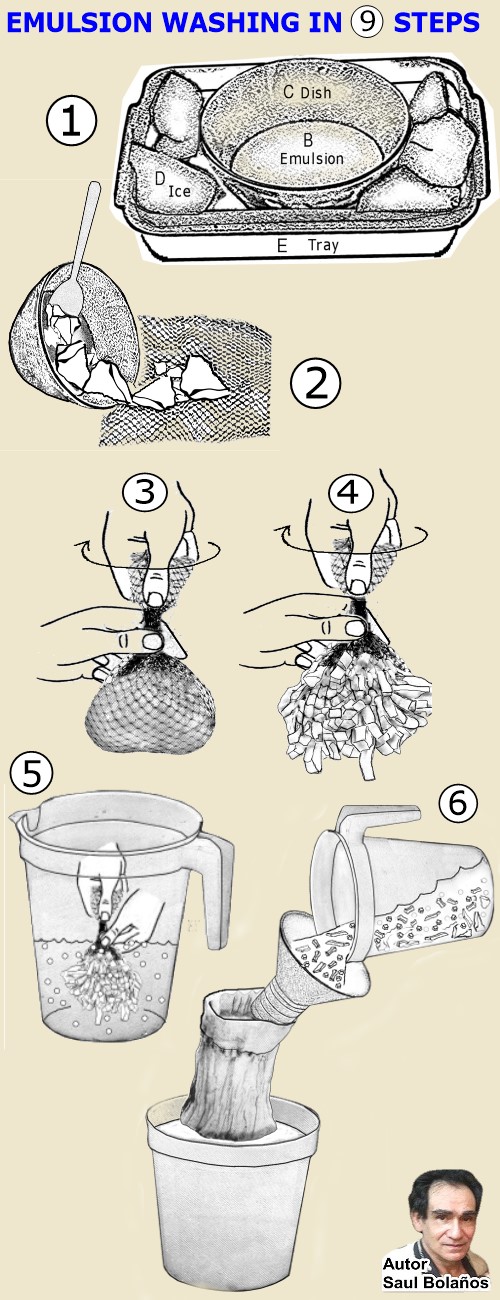 1. After mixing and/ or
first ripening:
1. After mixing and/ or
first ripening:
Set emulsion into a stiff jelly in ice water bath
for at least 30 minutes,
cover from excessive exposure to safelight
with carton or newspapers.
2. Scrape solid emulsion off the dish onto the net.
3. Form net into a ball and twist it with one hand.
4. Twist to force the jelly through the opening of the net. Do this under water as in step.
5. the jelly is squeezed trough the net under ice cold water so the shreds or noodles
will not stick together.
6.the shreds
(of many shapes and sizes)
are now collected inside the washing bag by pouring them through a wide mouth funnel so as not to loose any emulsion
shreds.
Once the shreds are inside bag,
Close bag with a string
or rubber band so shreds
will not be lost
in next washing step.
 7. in a 4 liter jar
immerse bag in 2 liters (or 2 quarts )of ice water (for 250 -500 ml of emulsion).
7. in a 4 liter jar
immerse bag in 2 liters (or 2 quarts )of ice water (for 250 -500 ml of emulsion).
Make sure there is always ice cubes
floating around to keep water cool at 5c ( 41 f )
or below
otherwise emulsion will absorb too much water.
Agitate bag frequently and change water every
5 minutes.
8. During washing, squeeze bag often to relocate the shreds inside
for a more effective washing.
Do this quickly so as
not to melt emulsion with warmth of hands.
Refer to TABLE 1 for washing times and details..
9. when finished washing, squeeze bag so as to press out as
much water as possible otherwise it will not give the required volume on melting;
specially if washing water was
too warm
(above 5c or 41 f )
If in doubt Drain excess of water by sitting bag in contact with a pile of newspapers for 30 minutes in total darkness.
10. After washing and draining place bag in contact with an empty glass or stainless
steel dish previously heated on a hot water bath
at: 45 -50c (113 - 122 f )
so emulsion on melting will flow into it.
Dish has to be large enough to contain the emulsion.
( about 1 liter or 1 quart is fine) (wash empty bag thoroughly)
proceed now to next step.
Second Ripening
(by applying more heat)
Begins here
after taking volume.
TESTING:
" RIPENING TIME "
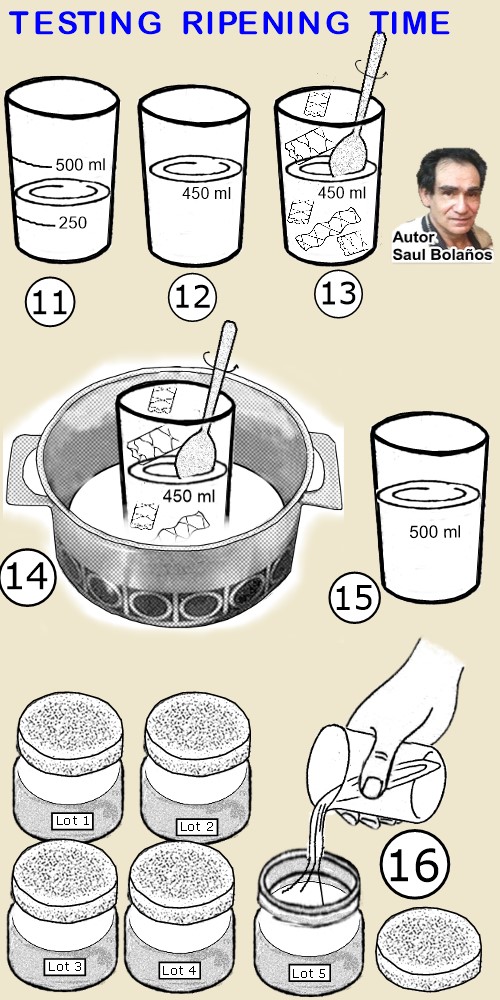 11. immediately after washing and mel-ting, place fluid
emulsion in a 1 liter beaker or glass jar previously marked with ink or tape to 400 and 500 ml volume.
11. immediately after washing and mel-ting, place fluid
emulsion in a 1 liter beaker or glass jar previously marked with ink or tape to 400 and 500 ml volume.
12. Add enough warm water to bring volume to 450
ml
13. Add the dry extra gelatine C, (if in leaf form
) cut in small pieces. Stir a while to wet gelatine and promote its dissolution.
14. Place glass in a hot water bath at 45-50c (113
- 122 f )to melt the gelatine. Agitate frequently . This may take 10 -15 minutes. When all gelatine has dissolved
(probe with your fingers) add antifoggant D, and..
15. ...Add a little more water to bring the final volume
to 500 ml. Emulsion has now a gelatine concentration of 8 %, good enough for coating at 35c or 95 f (if brought
instead to a total volume of 400 ml, concentration in gelatine will be 10 %.)
Emulsion is
now ready for the second ripening.
Do not add the finals E until the end of second ripening just before coating But to test the type of gelatine you are
using, Instead of ripening all of the bulk, divide the 500 ml in 5 separate lots of 100 ml each,
(so each lot
can be ripened and tested individually) as in next step.
16. Divide all the 500 ml of emulsion into 5 different lots, by pouring 100 ml of emulsion into 5
separate glass or stainless steel jars . Each one of this un-ripened emulsion lots will be ripened one by one in separate sessions if necessary. Riping is the action of submitting
liquid emulsion to heat.
Label the lots with masking tape. Place away with a cap on in absolutely light proof
containers and keep in total darkness until needed.
Gelatine in emulsion (without salicylic acid) will keep without
spoiling for about 3 - 4 days at room temperature. So there is plenty of time for the testing in the case they have to
be kept in the darkroom un- refrigerated, for light proof safety reasons. To make them light proof, wrap them very well
with several folds of tin foil followed by black paper if necessary.
Make sure the entire jar is securely
covered. Under refrigeration the lots will keep for more than 7 days (without the salicylic acid) .
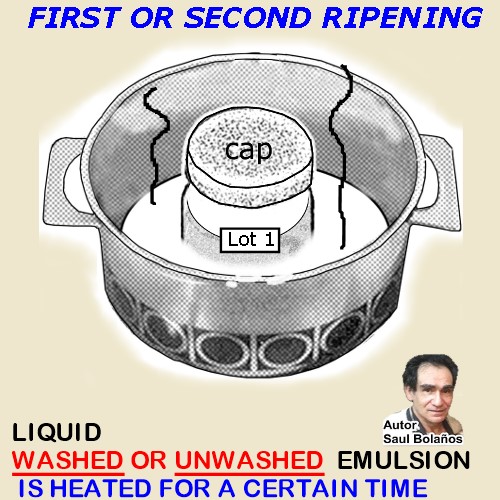 SECOND RIPENING
SECOND RIPENING
Ripen the washed emulsion lot to be tested by cooking in a hot in water bath
at 50c ( 122 f ) for 1.5 hours. (with cap on emulsion jar as seen in figure, with a lid on, the emulsion will not
condense) Do this in darkroom under red light do no cover the water bath vessel or place a lid on it to enclose
emulsion jar because heat will accumulate dangerously way above 50c. Agitate emulsion jar once for 10 seconds every 10
minutes. At the end of that time add finals E. cool to 35c ( 95 f) and coat on paper
and process.
1. NORMAL GELATINS
After ripening for 1.5 hours at 50c ( 122 f ) and adding the finals E You should have
a high contrast print, with clean whites, brilliant blacks and no fog. If this is the case, as it should be with the
vast majority of gelatines, proceed then to ripen the rest of the lots as described above and finish them by
adding finals E to each lot.
Once a good print has been obtained in 1.5 hours ripening
at 50 c (122 f) with normal good gelatines, If it is wanted to get more speed, do this:
Submit a new un-ripened
lot of 100 ml of emulsion to a ripening time of not 1.5 hours at 50c, as before, but to double that time, that is: 3
hours. Add finals, coat and test.
speed should have about doubled with little or no fog on the whites of the picture.
if taken to 4 or 5 hours ripening at 50c ; speed may increase further but with the appearance of fog in amounts that
may not be tolerable. Only ripening tests can determine the optimum ripening time for
any particular gelatine.
For a greater stability of the coated emulsion on storage, ripening should not be
taken too far; if it is found for example that speed doubles at 3 hours 50c, with no fog. and speed again doubles in 5
hours at 50c (122 f ) but with the appearance of noticeable fog; Then the ripening should be arrested at 3 hours 50c,
when there was no fog and the finals added to stabilize it at this stage.
2. OVER
ACTIVE “NOT CLEAN” GELATINES If After ripening for 1.5 hours at 50c ( 122 f ) and adding the finals E, coating and testing you got a “low contrast “ print
with no deep blacks and no clean whites, grayed with fog, you got a bad gelatine which is rare and useless for emulsion
making. In such case Repeat the emulsion with another type of gelatine.
3. If After ripening for 1.5 hours at 50c ( 122 f ) you got a print with “high
contrast ”, deep blacks but very impure whites grayed with fog, this may also be a case of bad gelatine but before
blaming the gelatine, chances are the fog may have been caused either by:
A) Faulty
weighting of reactants in which case the silver was left in excess of the bromide ( more than 10 grams silver nitrate
per each 8 grams potassium bromide B) Precipitation temperature too high, the
gelatine salts solution was heated above 40c (104 f) and not at 35 - 38c ( 95 - 100 f) as recommended.. C) Emulsion was stroke with white light or excessive exposure to red safelight during ripening or
storage, D) Developer too hot and/or developing time too long. Expose to develop
never for more than 1.5 minutes in kodak’s Dektol diluted 1:2 with water at exactly 23c (73 f) and never above that
temperature. At 20c ( 68 f) expose to develop: never more than 3 minutes...(same applies for other film or paper
developers similar to Dektol)
If you are sure none of the above are the causes of the fog, take a new un-ripened emulsion lot and
ripen it for half the time only, that is - 45 minutes at 50c (122 f ) instead of the recommended time of 1.5 hours. At
the end of that time add finals, solution E.
coat and test.
Fog must have decreased. The whites must be now cleaner. If
after this shorter 45 minutes 50c ripening time print still has high contrast, strong blacks but still a little fog on
the whites; get a new un-ripened 100 ml emulsion lot and submit this to a ripening of only 20- 30 minutes at 50c (
122f) as before. ( instead of 45 minutes) add finals, coat and test. Whites should be even cleaner.
Over all, if
emulsion is not clean, this type of gelatine is not to be recommended, it is rare, it is not “normal” and it will have
a tendency to produce fog on storage (specially in liquid form and worse still un-refrigerated). It should have
withstood at least 1 hour ripening time at 50c without fog. ( 122 f ) with the excellent emulsion formula given for
testing. Try another type of gelatine using same formula and procedure described.
coating, or during developing.
it is recommended to use "Gelitas" Brand of Leaf Gelatine,See Chapter on
Gelatine. SECOND RIPENING With “ Inert”
Type of Gelatins Ripen the emulsion lot to be tested by cooking in a hot in water bath at 50c (122 f ) for 1.5
hours. (with cap on emulsion jar as seen in figure, with a lid on, the emulsion will not condense) Do this in
darkroom under red light do no cover the water bath vessel or place a lid on it to enclose emulsion jar because heat
will accumulate dangerously way above50c.
Agitate emulsion jar once for 10 seconds every 10 minutes. At the end of that
time add finals E.
cool to 35c ( 95 f) and coat on paper and process.
“Inert “ Gelatines Sulphur Sensitization
If after ripening one or the
first of the emulsion lots for 1.5 hours at 50c ( 122 f ) and adding the final E,
coating and testing; - you got an image with “very low contrast” but the whites are pure and clean with no fog,
but it is too soft and flat with no deep or strong blacks (about grade 0) You have an inert
type gelatine which is not very rare now days.. In this case proceed with a new un-ripened emulsion lot and
sulphur sensitize it with thiosulphate just before ripening as follows:
Melted un-ripened washed emulsion lot of ............100 ml
sodium thiosulphate penta hydrate 1:1000 sol:..... 2 ml
Mix thoroughly. Ripen for 1.5 hours at 5oc ( 122 f ) add finals solution E. coat and test. If this was indeed an
“ inert “ type of gelatine containing no sensitizers; the print should have now
strong blacks, very high contrast (grade 3 +) no fog and pure whites. Note the thiosulphate is the normal “hypo” or
photographic fixing agent in pure form. You have now learned the basic steps of emulsion making and testing of
gelatines.
Assuming you have already found the limits of second ripening time until
Fog is no longer tolerable with the gelatine being used, continue now to learn how to get more speed with this same
formula given above, Varying only the first ripening time. But before see: "Color
Sensitizing of this emulsion with Erythrosine"
OR ORTHO-CHROMATIZATION with Erythrosine Dye added Directly to Emulsion Erythrosine
can be added to ammoniacal emulsion # 1, to color sensitize it. Coated on plates for negative work, Erythrosine will reproduce the greens and yellows of a lighter color on the final
positive. It is desirable for landscape work and portraits.
IMPORTANT:
add the dye before adding the stabilizer the
Chrome Alum & Salicylic acid. If added before these may reduce the color sensitizing action.
Prepare Dye Stock Solution: Erythrosine 1 gm
Ethyl Alcohol 1:1 with distilled Water ..... 500 ml
stock sol above keeps indefinitely in the dark.
For a better sensitization: 5 min.
before adding the dye add to every
500 ml of the ripened emulsion melted at 40c +
strongest ammonia: diluted 1:10 with water ...... 0.5 ml
hold, 5m / 35 - 40c / and of the above Stock
dye now add per every 500 ml of emulsion:......7 .5 ml
hold at 35 -40c 5-10 min before coating.
with above quantity Erythrosine red stain will wash out even out
of orthochromatized “paper“ . If coated on glass plates up to 15 ml stock sol of erythrosine can be used, a
little residual pink stain on negative will not matter and the sensitizing action is stronger.
For maximum marked
action on greens expose plate with yellow filter in front of lens to depress the natural “extra blue and UV
sensitivity” of the silver grain. Exposure may have to be increased according to yellow filter factor.
 How to Obtain More Sensitivity
How to Obtain More Sensitivity
with Ammonia Positive Emulsion #
1
Assuming you have tested the gelatine, and got a good emulsion.
There are several ways now to get more speed with this same ammonia formula, to do so, do only one of the following:
1. First Ripen in the Cold for 24 Hours After precipitation at 35-38c, ( adding
silver to bromide solution) set emulsion immediately in ice water bath as given before, but instead of waiting only
30-60 minutes before washing.
Place emulsion ( in light proof container, see ) to ripen in the cold inside refrigerator
( not in freezer) at around 5 to 10c ( 41-50f ) for a period of 24 HOURS. During this time the ammonia will act
enlarging the silver grain.
At the end of that time. brake emulsion in pieces and wash, After melting in hot water
bath, proceed to second ripen as given before.
Try first a Second Ripening time of 1.5 hours at 50c (122 f) speed
should more than double. To repeat results ripen at same temp and same time every time.
Add
finals E.,
as usual to stabilize at the end of Second ripening, Do that once
the optimum time has been found by trial and error.
2. First Ripen at Room Temperature for 12 - 24 hours this second method is more
dangerous because it gives a lot more speed but may cause fog if second ripening time is prolonged. After precipitation
at 35-38 c, do not set emulsion immediately in ice water bath as given before,
just do not apply more heat and leave
emulsion vessel at room temperature ( 20-28c) in absolute darkness for 12 - 24 hours During that time the silver grain
will grow even larger yielding a more sensitive emulsion. At the end of the chosen time. Set emulsion in ice water bath
for at least 1 hour, until as firm as a hard rubber ball.
brake, wash, Re-melt and second ripen at 50c as before, Try
second ripening one emulsion lot for 45 minutes , another for 1.5 hours or more. Arrest heat and stabilize when the
first traces of fog appear.
 The more speed the less contrast. Take careful notes as to the room temperature.
Higher room temps will produce more speed than lower ones.
The more speed the less contrast. Take careful notes as to the room temperature.
Higher room temps will produce more speed than lower ones.
To repeat results conditions must be exact with no variables
as to time and temperature. If too much speed accompanied with fog was obtained with 24 hours ripening at room
temperature; Cut time to 12 hours in next emulsion batch.
Second ripen for 45 min to 1.5 to 3 hours at 50c, after
washing as before. Speed will depend on type of gelatine, but all conditions being equal, Second method will produce
more speed, of course, than the first. TO AVOID FOG: The Longer First Ripening Time is, the Shorter the Second Ripening
Time Must be. tests have to be made.
ASA 3 to ASA 6 For negative work a speed , (depending on the gelatine) of about
at least ASA 3 with a 24 hours ripening in the cold, ( first method) to about ASA 6 (second method) should be obtained.
For coating glass plates and exposing in the camera; ASA 3 is a practical minimum speed. With this speed,
emulsion coated on paper should yield a high contrast paper grade of about 3.0 -with clean whites if paper developer
temp is not above 22c and developing time longer than 2 minutes. ( MQ “D 72” type of paper developer / see later).
IMPORTANT:
To Eliminate Traces of AMMONIA AFTER
WASHING
The more the emulsion is left in contact with the ammonia, the more difficult it will be to wash it
out completely. It is advised to Prolong emulsion washing times by 50 % or so when First Ripening time is prolonged. On
Re-melting washed emulsion, it is normal to detect a slight odor of ammonia, which disappears after a few minutes as
the gelatine absorbs it without any harm, if the detectable odor of ammonia is too strong or if it persists more than
10 minutes after re-melting, Add 1 ml of Glacial Acetic Acid in 10 ml of water. ( per every 10 grams of Silver
Nitrate used to make the emulsion) That quantity of acid will neutralize the ammonia when it is present in moderate
amounts. Continue then to Second Ripen as normal.
 Keep uncoated
Liquid emulsion under Refrigeration
Keep uncoated
Liquid emulsion under Refrigeration
If the 2 ml 10 % alcoholic solution of salicylic acid was added to the finished
emulsion containing 40 grms gelatine (dry weight) as given for the ammoniacal formula #
1,
Uncoated humid Emulsion should keep more than 6 months under refrigeration at 5c (23 f) or under,
without mould appearing. At 5c or under, emulsion will not ripen rapidly, that is, the silver crystal will not grow ,
chemical activity is retarded at that temperature It should then maintain its original speed and contrast for 6 months
or so as long as it is not heated or left uncoated out at room temp for many days .
Do not heat it again or leave it
out of the fridge for long times unless all of it is going to be coated. Note that once coated, emulsion will loose
humidity on drying, and it will not spoil or biodegrade because it has lost most of its water.
Gelatine emulsion,
once coated will retain, on drying, only 10% humidity which is normal.
Before Coating Solid Emulsion...
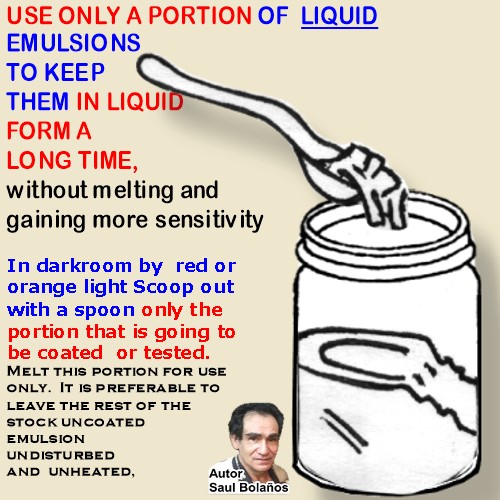 After chilling the “Finished” ripened
emulsion for a few hours (or days or weeks) Take out of the refrigerator, it will be a solid milky white mass.
After chilling the “Finished” ripened
emulsion for a few hours (or days or weeks) Take out of the refrigerator, it will be a solid milky white mass.
In
darkroom by red or orange light Scoop out with a spoon only the portion that is going to be coated or tested. Melt this
portion for use only.
It is preferable to leave the rest of the stock uncoated emulsion undisturbed and unheated, and
to return it inside its light proof container to the refrigerator as soon as possible where uncoated will keep ready to
be used again for a long time.
If left at room temp it will continue to gain speed, and it will eventually fog,
depending on its degree of sensitivity. Fast negative emulsions may fog in only hours or days at room temp in humid form. But once coated, on loosing its water,
chemical changes are enormously retarded, and will keep for months or years depending on storing conditions.
Left over,
melted by heat, but uncoated emulsion should not be placed back together with un-heated stock emulsion because it this
portion was heated too long or too hot ; it may have gained more speed than the unheated portions. Coat any left over
heated emulsion on paper and use it for exposure test strips instead.
COATING LIQUID MELTED EMULSION
For melting ice cold emulsion, for coating.
after scooping out the estimated quantity or portion to be used, and placing it in a small glass jar, it is immersed in
water at 50c ( 122 f) But just long enough to melt all of the emulsion until it all liquefies with out ever becoming as
hot as 50c (122f When all has become a liquid, it is taken out of the hot water bath, it will have a long liquid phase.
But in cold weather, to keep it fluid, it is kept warm by sitting it above the water level as shown in the figure below. Emulsion is non toxic; it can be handled and probed with fingers.To
Keep Emulsion Jar in Water Bath Just Warm Enough For Coating
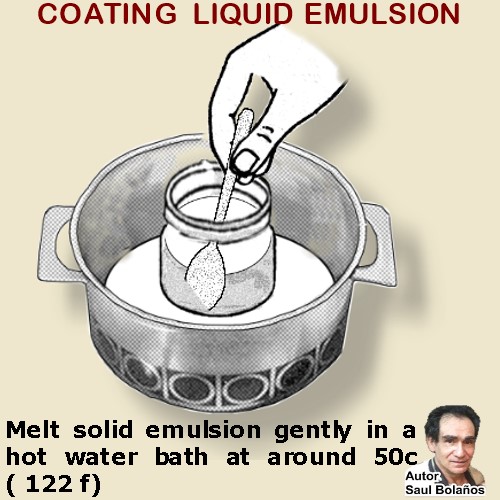 Sit a larger dish inside water bath at
50c (122f) and on top of it, place the already liquefied emulsion jar. as shown in figure to the right. In this way
emulsion will keep just warm enough to maintain fluid for coating at around 30-35c (86-95 f).
Sit a larger dish inside water bath at
50c (122f) and on top of it, place the already liquefied emulsion jar. as shown in figure to the right. In this way
emulsion will keep just warm enough to maintain fluid for coating at around 30-35c (86-95 f).
with such a gentle heat,
emulsion will not ripening too much and it will keep it from developing fog. This is a
capital importance for rapid negative emulsions, at 35c ( 95 f) as long as the same portion of emulsion is not
heated more than 4 hours, speed will not change and fog can be avoided.
To insure the avoidance of fog then, melt just
enough emulsion for the job and coat it before 4 hours. This method has the added advantage that the pre-regulated
thermostat settings of 50c, of the heating plate will not be disturbed, to continue making more emulsions without the
trouble of regulating the heat again.
SHELF LIFE OF COATED MATERIAL
All material coated in any work session will retain on drying, the speed and contrast that the emulsion has acquired at
any particular stage of its uncoated life in humid form. So date with notes each coated lot of materials and save this
written data along the paper that was coated for test exposures.
Pure chemically inert coated material like watercolor
paper or glass, will retain same speed without fog for a long time: 60 days to 3 years or more. According to original
speed and all according also to storing conditions, and the amount of time and temperature the fresh liquid emulsion
was heated before coating; it may gain twice the speed in a later date and finally it will develop Age fog giving
impure whites.
For consistency it is advised to process coated material as soon as possible. Less than 4 weeks on
chemically active surfaces like materials painted with “any type” of commercial paints Coated material frozen below 0 c, will not develop fog or change speed. Thinner: for coating
large areas: dilute emulsion or thin down with 5-10 % of water to facilitate spreading.
READ NEXT CHAPTER 6
COATING GLASS PLATES AND PAPER
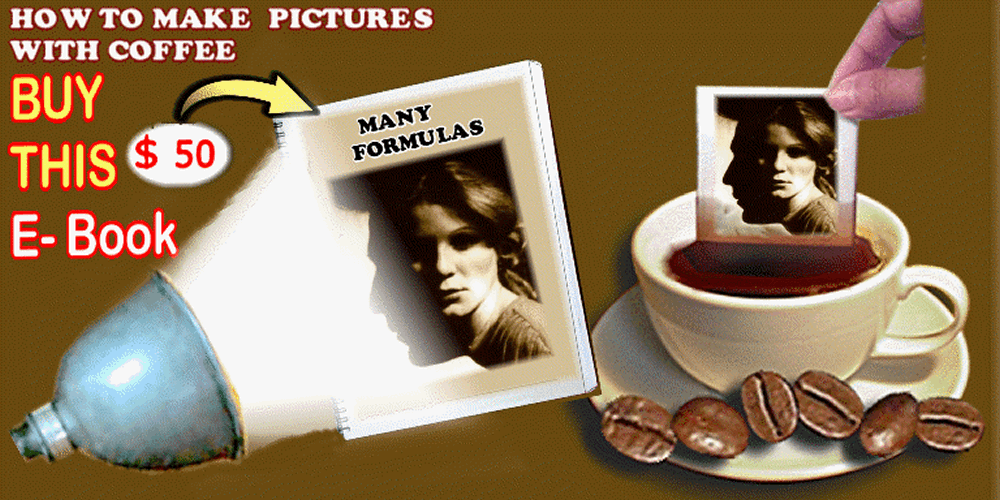 ABOVE ONE OF MY MANY OTHER BOOKS ON PHOTOCHEMISTRY
ABOVE ONE OF MY MANY OTHER BOOKS ON PHOTOCHEMISTRY
TEXT MESSAGES
IN
COSTA RICA
6012 4695
![]()
CONTACT

COSTA RICA © 2025, saul bolaños
CAFEDESAUL@GMAIL.COM